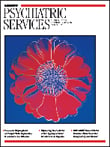Letter
Successful Use of VNS for Depression
To the Editor: The observation that patients using vagus nerve stimulation (VNS) for epilepsy showed improved mood led to studies resulting in approval of VNS by the U.S. Food and Drug Administration for the adjunctive long-term treatment of chronic or recurrent unipolar or bipolar depression for adults who have not had a positive response to four or more adequate antidepressant trials ( 1 ). The putative mechanisms of action include changing concentrations of neurotransmitters and functional activity of brain areas involved in mood disorders.
Ms. A is a 72-year-old divorced white female with a long history (more than 30 years) of DSM-IV major depressive disorder, recurrent, severe, without psychotic features. Her son committed suicide in December 2004, which led to an exacerbation of her symptoms. She has been seen in our community mental health center since February 2001. Current medications are lamotrigine, bupropion, lithium, and paroxetine.
The National Depression Management Leadership Initiative of the American Psychiatric Institute for Research and Education recommends that depressed patients self-administer the brief Patient Health Questionnaire (PHQ-9) ( 2 ) as one means of improving clinical management practices. The maximum severity score is 27, and a score of less than 5 indicates minimal depression. Ms. A's VNS scores for several months in 2005 were 17 on June 15, 19 on July 2, 16 on July 14, 22 on July 22, 26 on August 18, 15 on August 26, and 23 on September 15.
In late 2005 I discussed therapeutic options with Ms A. Multiple medications and individual and group psychotherapies had not helped her. Electroconvulsive therapy had helped, but Ms. A insisted that she did not want this treatment again, citing past side effects, especially perceived memory deficits. We discussed VNS, and I described possible adverse effects, particularly hoarseness, cough, paresthesia, and dyspnea. Most of these effects occur only during the brief stimulation periods and are short term; they generally diminish over time, can be lessened by adjusting the settings, and can be controlled by use of a magnet (with which the patient can stop the stimulation). Ms. A was especially encouraged by research showing improvement increasing over time. Like many such patients, she was "willing to try anything" that held promise to relieve her depression.
Ms. A was given a video educational package, and she talked with staff at Cyberonics, Inc., the manufacturer of the device, and with patients who had been treated with VNS. It should be noted that by October 2004 VNS had been used with more than 32,000 people to treat seizures, representing 80,000 device-years of implant experience. The same procedure is used to treat depression.
Cyberonics facilitated referral to a prominent local neurosurgeon, who consulted with Ms. A and implanted the device without a problem. On October 28, 2005, I activated the system in my clinic office with equipment loaned to me by Cyberonics. Two weeks later, I increased the dose to the next step. Ms. A's PHQ-9 score was 1. She reported doing things that she had not done for years. "I'm so happy but not hyper," she said. Her PHQ-9 scores were 2 on December 8, 1 on December 21, 5 on January 18, and 1 on February 1. At this writing, April 11, 2006, her current PHQ-9 score is 5. Ms. A noted that the score was higher because of unrelated knee pain. Her knee problem led to the only significant problem with VNS so far—she was not being able to have an MRI, and assessment of her knee required other examination techniques. Ms. A has reported no adverse effects, except for a rare throat "tingle."
In this case of chronic, treatment-resistant depression, VNS therapy was successfully and easily initiated under routine clinic conditions by an admittedly "computer-challenged" psychiatrist. In addition, the PHQ-9 proved valuable as a means of monitoring depression over time.
1. Rush AJ, Marangell LB, Sackeim HA, et al: Vagus nerve stimulation for treatment-resistant depression: a randomized, controlled acute phase trial. Biological Psychiatry 58:347-354, 2005Google Scholar
2. Kroenke KM, Spitzer RLM, Williams JBD: The PHQ-9: validity of a brief depression severity measure. Journal of General Internal Medicine 16:606-613, 2001Google Scholar



